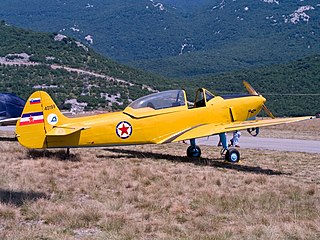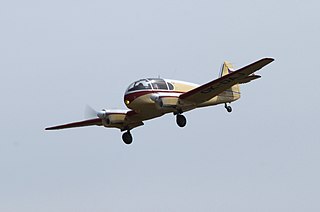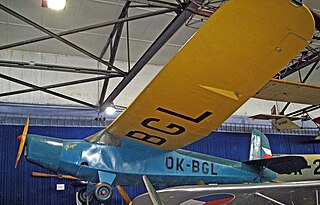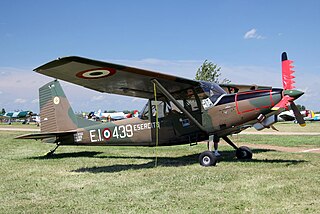
The Ikarus Aero 2 was a piston-engined military trainer aircraft built in Yugoslavia in the years following World War II, although the design pre-dated the war.

The UTVA Aero 3 was a piston-engined military trainer aircraft built in Yugoslavia to replace the Ikarus Aero 2 then in service. One hundred ten were built, in Yugoslav Air Force service from 1958 to mid-1970s. It was superseded by the UTVA 75.

The Aero 45 was a twin-piston engined civil utility aircraft produced in Czechoslovakia after World War II. Aero Vodochody produced the aircraft in 1947–1951, after which the Let Kunovice rolled out these planes until 1961. In 1958 the Ae-45S became the first Czechoslovak plane to cross the Atlantic Ocean. It was the first product of the nation's postwar aviation industry and proved a great success, with many of the 590 produced being exported.

The UTVA 75 is a light utility aircraft produced by the Serbian aircraft manufacturer UTVA. It was first introduced in the late 1970s and has since been used primarily for training, reconnaissance, and light transport roles. Known for its reliability and versatility, the UTVA 75 has been adopted by several military and civilian operators around the world.

The Alaparma Baldo was an unusual two-seat light monoplane produced in Italy shortly after World War II. Designed by Adriano Mantelli, it featured an egg-shaped fuselage with cabin doors that hinged upwards and to the back. The conventional tailplane with single fin and rudder was carried on twin booms, either side of a pusher engine installation. The undercarriage consisted of a single mainwheel under the fuselage pod, a small tailwheel not far behind it, and outrigger wheels on the wingtips.

The Avions Fairey Junior, also known as the Tipsy Junior was a single-seat light aircraft built in Belgium following World War II.

The Praga E.114 was a single-engine sport airplane, designed and manufactured by the Czechoslovakian company ČKD-Praga. Due to its light weight it was also called Air Baby.

The Zlín Z-XII was a Czechoslovak two-seat sports aircraft, and the first major design success by the Zlínská Letecká Akciová Společnost (Zlín) aircraft manufacturing company, after its founding in Otrokovice after the takeover by the Bata Group.

The FMA 20 El Boyero ("Shepherd") was a light utility aircraft produced in Argentina in the 1940s. It was a conventional high-wing strut-braced monoplane with a fixed tailskid undercarriage, seating two side by side in an enclosed cabin.

The SIAI-Marchetti SM.1019 is an Italian STOL liaison monoplane built by SIAI-Marchetti for the Italian Army. It is a turboprop-powered derivative of the Cessna O-1 Bird Dog.

The Macchi MB.308, later Aermacchi MB-308, is a light aircraft produced in Italy in the late 1940s.

The Ikarus 451 is a family of research aircraft designs built in Yugoslavia in the 1950s, all sharing the same basic airframe, but differing in powerplants and cockpit arrangements. One member of the family Ikarus 451M became the first domestically-built jet aircraft to fly in Yugoslavia, on 25 October 1952.
The Ikarus 452 was an experimental jet aircraft built in Yugoslavia in 1953. It was a stubby mid-wing cantilever monoplane of pod-and-boom configuration, with twin jets mounted one atop the other at the rear of the fuselage nacelle, with separate intakes for the lower engine and the upper engine. The twin tails and horizontal stabiliser were carried at the ends of booms that extended rearwards from the wings, with a short fin extending from the top of the rear fuselage to also meet the stabiliser. The flying surfaces were sharply swept, and construction throughout was of an experimental alloy.
The Ikarus IO was a biplane flying boat produced in Yugoslavia in the late 1920s. It was a conventional flying boat design for its day, featuring a large single-bay wing cellule, the staggered wings of slightly uneven span braced with N-struts. The pilot and observer sat side by side in an open cockpit, and a gunner sat in an open position ahead of them, in the bow. The pusher engine and frontal radiator were carried on struts in the inter-plane gap.
The Yakovlev Yak-20 was an experimental piston-engined trainer developed in the Soviet Union in 1949. It did not go into production.

The Ambrosini Rondone is an Italian-designed two/three-seat light touring monoplane of the early 1950s.
The UTVA-60 is a Yugoslavian light aircraft of the 1960s. First flying in 1959, it was built by UTVA for both the Yugoslavian armed forces and for civilian use.

The Rogožarski SIM-VI was a single-engined, two-seat, low wing aircraft designed as trainer in Yugoslav before World War II. It was designed and built at the Rogožarski factory in Belgrade.

Utva 213 Vihor was a late 1940s Yugoslavian two-seat advanced trainer.
The LIBIS 180 is a Slovenian sporty three-seater mixed-construction aircraft, mostly wooden with a tail wheel, designed and produced at LIBIS aircraft during Yugoslavian period.















